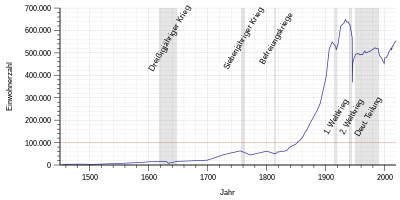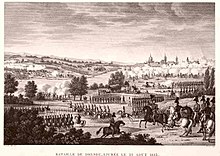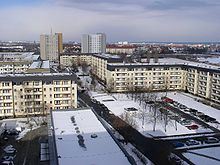Population development of Dresden
This article presents the population development of Dresden in tables and graphs.
The following overview shows the number of inhabitants according to the respective territorial status. Up to 1831 these are mostly estimates, then census results (marked ¹) or official updates from the city administration (until 1944), the state central administration for statistics (1945 to 1989) and the state statistical office (from 1990). From 1834 the information relates to the “customs clearance population”, from 1871 to the “local population”, from 1925 to the resident population and since 1966 to the “population at the place of the main residence”. Before 1834, the number of inhabitants was determined according to inconsistent survey methods.
Population development
From 1453 to 1849
(respective territorial status)
The population development of Dresden can be traced back to the Middle Ages . Until the beginning of modern times , the city had only a few thousand inhabitants. In 1453 there were 3100 and in 1489 3700. After the fire in 1491 there were around 2500 residents in 1501. It should be noted that Altendresden (today's Neustadt) and the suburbs did not belong to the city until the middle of the 16th century. If this is taken into account, the total city in 1489 comes to max. 5500 and 1501 to around 4500. The population grew only slowly and fell again and again through the numerous wars, epidemics and famine.
The outbreak of the plague between 1566 and 1584 killed a total of more than 1,000 people, in 1585 alone 1209 people. During the Thirty Years War in 1632/1633 around half of the population fell victim to a plague epidemic and famine. In 1699 the city had 21,000 inhabitants, by 1727 this number had doubled to 46,000.
In the Seven Years' War (1756–1763) Dresden was besieged several times by Prussian troops. Considerable destruction and a decrease in population were the result, from which the city recovered only slowly. The battle of Dresden in 1813 between the troops of Napoleonic France and their opponents during the Wars of Liberation also had an impact on urban development.
|
|
¹ census result
From 1850 to 1945
(respective territorial status)
With the beginning of industrialization , population growth increased. While around 62,000 people lived in the city in 1800, the number of inhabitants exceeded the limit of 100,000 in 1852, making the capital of the Kingdom of Saxony a major city . Along with Munich and Cologne (also major cities since 1852), Dresden was one of the fourth oldest major German cities after Berlin (since 1747), Hamburg (1787) and Breslau (1840). By 1880 the population had grown to 220,000 and in 1905 it was over half a million.
At the beginning of the 20th century, Dresden was one of the five most populous cities in the German Empire . The incorporation of numerous places in the area on April 1, 1921 brought a profit of 58,450 people. In 1933 the highest value in the history of Dresden was recorded with 649,252 inhabitants. On January 1, 1934, the population fell due to Albertstadt , which was spun off as an independent manor district (7,109 inhabitants 1933); they were reintegrated on July 1, 1945. The census on May 17, 1939 showed 629,713 inhabitants, of which 281,379 men and 348,334 women.
During World War II , the city was the target of bombing by the Royal Air Force (RAF) and the United States Army Air Forces (USAAF). The Allied air raids on Dresden between August 1944 and April 1945 killed around 25,000 people and around 75,000 apartments were completely destroyed. Overall, the city lost 41.5 percent of its residents (261,697 people) through evacuation, flight, deportations and air strikes. The population decreased from 630,216 in 1939 to 368,519 in April 1945.
The results of the “consumer group statistics ”, which were obtained from the data of the food allocation and published in 1953 by the Federal Statistical Office , provide a more realistic assessment of the population development in World War II . According to the “Small Consumer Group Statistics”, 571,609 civilians were cared for in Dresden at the beginning of February 1943, 580,292 at the end of August 1943, 563,749 at the beginning of February 1944, 563,049 in mid-August and 571,641 at the beginning of December 1944. The number of “communal caterers” included in these numbers rose continuously from 16,011 to 40,739 during this period.
|
|
¹ census result
Source: Dresden City Administration
From 1945 to 1989
(respective territorial status)
After the Second World War, the population increased due to the influx of numerous refugees and displaced persons from the German eastern regions and as a result of several incorporations. Albertstadt, Dölzschen and Gittersee were incorporated on July 1, 1945 . On July 1, 1950, the town of Klotzsche (16,152 inhabitants on December 1, 1945) and other places in the vicinity of Dresden were incorporated. On August 10, 1950, Oberpoyritz and Söbrigen were incorporated . By 1964 the population rose again over 500,000, by 1983 to 522,000.
From 1972, many people moved into the prefabricated buildings in the new districts of Prohlis and Gorbitz on the outskirts of the city as part of the housing construction program . But also in the city center new residential quarters with prefabricated buildings emerged on the rubble old quarters, for example in Johannstadt. While new buildings were being built on a large scale, numerous old buildings, especially Art Nouveau apartments in Dresden-Neustadt, fell into disrepair.
In 1988, a year before the fall of the Wall in the GDR , 518,000 people lived in Dresden. With the beginning of the wave of refugees from GDR citizens after the opening of the Iron Curtain between Austria and Hungary on August 19, 1989 and the opening of the inner-German border on November 9, the population began to decline. At the end of 1989 the city still had 501,000 inhabitants.
In addition to the German resident population, soldiers and officers lived with their family members in and around Dresden. In addition to the soldiers of the 1st Guards Armored Army of the Soviet Union, there were also members of the military academy "Friedrich Engels" , the Transport Fliegerstaffel 24 and the 7th Panzer Division of the National People's Army . Never before in peacetime have there been so many military personnel in Dresden as between 1945 and 1990. In the years after German reunification, all military units were relocated or disbanded.
|
|
|
¹ census result
Source: State Central Administration for Statistics
From 1990 to 1999
(respective territorial status)

From January 1990 to December 1998 the number of “population at the place of the main residence ” sank by emigration and relocation to surrounding communities (see also suburbanization ) to just under 453,000 inhabitants and thus only slightly less than in December 1945 due to the war. Leave emigration and relocation to the surrounding area observe each other in two separate waves, with relocations to the surrounding area only occurring significantly in the mid-1990s due to increasing prosperity (in particular to enable residential property). The incorporations carried out in 1997 and 1999 (25,483 people on January 1, 1999) partially or fully offset the aforementioned effects.
|
|
¹ year with incorporations
From 2000
(respective territorial status)
Since 1999 the population has increased again due to significant migration surpluses and reurbanization . In addition to Munich and Bonn, the population of Dresden is one of the fastest growing in Germany with an annual increase of around 0.68 percent. A slight acceleration in the increase was observed up to 2006.
In 2006 there was even a slight surplus of births and the number of “population at the location of the main residence” exceeded the mark of 500,000. As a result, the number of inhabitants fluctuated by more than 50,000 within a decade. As a reason for the (recently accelerated) increase, in addition to the subsided suburbanization in the first years of the 21st century and the relatively high birth rate, the secondary residence tax is cited, which led to the conversion of many secondary residences into main residences.
While the city of Dresden in 1939 to eighth place was the largest German cities, it's on to 2006 13th fallen from then to rise by relatively high growth rates again in 11th place (Leipzig and Hanover overtaking). On December 31, 2011, the provisional official population for Dresden was 529,781 (only main residences and after comparison with the other state offices) according to the state statistical office of the Free State of Saxony . Based on the corrected data from the 2011 census , a new population projection began. According to the State Statistical Office, Dresden had 517,765 inhabitants on December 31, 2011.
|
|
|
¹ census result (2011 census)
Source: State Statistical Office of the Free State of Saxony
Population forecast
The Statistical Office of the Free State of Saxony published on April 19, 2016 the “6. Regionalized population forecast for the Free State of Saxony up to 2025 ”in two different versions. The two variants differ in the assumptions on foreign migration, the intra-German migration exchange and the frequency of births. In addition, the course over time and the intensity of the change in the individual components play a role. The forecasts of the 5th population forecast published in 2010 for 2020 (549,000 and 528,800) and 2025 (554,000 and 523,300) have been revised upwards significantly.
Projected population in the two variants up to 2030 (area status January 1, 2016):
| date | version 1 | Variant 2 |
|---|---|---|
| December 31, 2015 | 549,300 | 542,300 |
| December 31, 2020 | 582,300 | 564,800 |
| December 31, 2025 | 587.100 | 577.200 |
| December 31, 2030 | 591,700 | 583.100 |
Source: 6. Regionalized population forecast by the State Statistical Office of the Free State of Saxony
In their 2009 publication “Who, where, how many? - Population in Germany 2025 ”, in which the Bertelsmann Foundation provides data on the development of the population for all municipalities with more than 5,000 inhabitants in Germany, an 8.0 percent increase in Dresden between 2006 and 2025 (40,616 people) is predicted.
Absolute population development 2006-2025 - forecast for Dresden (main residences):
| date | Residents |
|---|---|
| December 31, 2006 | 504.795 |
| December 31, 2010 | 519.748 |
| December 31, 2015 | 533.176 |
| December 31, 2020 | 541,805 |
| December 31, 2025 | 545.411 |
Source: Bertelsmann Foundation
Absolute population development 2009–2030 - forecast for Dresden (main residences). During this period, the population is expected to increase by 60,800 inhabitants or 11.77%.
| date | Residents |
|---|---|
| December 31, 2009 | 516.730 |
| December 31, 2015 | 544.830 |
| December 31, 2020 | 561.760 |
| December 31, 2025 | 572,850 |
| December 31, 2030 | 577,530 |
Source: Bertelsmann Foundation
Population structure
| population | As of December 31, 2016 |
|---|---|
| Residents with main residence | 553.036 |
| of which male | 275.764 |
| Female | 277.272 |
| Foreigners | 37,385 |
| Proportion of foreigners in percent | 6.76 |
Source: State Statistical Office of the Free State of Saxony
age structure
The following overview shows the age structure as of December 31, 2006 (main residences).
| Age | population | Percentage |
|---|---|---|
| 0 - 5 | 26,369 | 5.2 |
| 6-14 | 27,179 | 5.4 |
| 15-17 | 12,932 | 2.6 |
| 18 - 24 | 56,757 | 11.2 |
| 25-29 | 45.102 | 8.9 |
| 30-39 | 70,526 | 14.0 |
| 40-49 | 70,915 | 14.0 |
| 50 - 59 | 59,809 | 11.8 |
| 60-64 | 28,808 | 5.7 |
| over 65 | 106,398 | 21.1 |
| All in all | 504.795 | 100.0 |
Source: State Statistical Office of the Free State of Saxony
Districts
Dresden is divided into ten districts and nine localities. The city districts (until 2018: "Ortsamtsgebiete") were formed in 1991 from what was then the city area, while the localities are represented by areas and municipalities incorporated between 1997 and 1999.
The district with the highest population is Blasewitz , while the largest is Loschwitz . The largest and most populous village is Schönfeld-Weißig , which extends in the Schönfeld highlands . Dresden city center is located in the districts of Altstadt and Neustadt .
The nine localities, some of which also consist of several districts, are formerly independent communities that were only incorporated at the end of the 1990s. One exception is the Kauscha district , which until 1999 belonged to Bannewitz and was incorporated into the Prohlis district.
The population figures in the following table refer to December 31, 2013 (main residences).
(OA = city district, OS = locality)
| Surname | Area in km² | population | Inhabitants per km² | |
|---|---|---|---|---|
| OA | Old town | 17.00 | 53,667 | 3.157 |
| OA | Blowjoke | 14.48 | 85.209 | 5,885 |
| OA | Cotta | 19.34 | 71.093 | 3,676 |
| OA | Klotzsche | 27.10 | 19,992 | 738 |
| OA | Leuben | 13.05 | 38,814 | 2,974 |
| OA | Loschwitz | 68.84 | 20,064 | 291 |
| OA | Neustadt | 14.85 | 48.271 | 3,251 |
| OA | Pieschen | 16.20 | 52,770 | 3,257 |
| OA | Plauen | 15.80 | 54,396 | 3,443 |
| OA | Prohlis | 21.10 | 56,528 | 2,679 |
| OS | Old Franconia | 1.28 | 1,116 | 872 |
| OS | Cossebaude | 8.04 | 5,641 | 702 |
| OS | Gompitz | 11.72 | 3,147 | 268 |
| OS | Langebrück | 6.95 | 3.714 | 534 |
| OS | Mob sweetheart | 8.50 | 1,489 | 175 |
| OS | Oberwartha | 2.03 | 401 | 197 |
| OS | Schönborn | 5.20 | 500 | 96 |
| OS | Schönfeld-Weißig | 41.33 | 12,941 | 313 |
| OS | Weixdorf | 15.49 | 6,057 | 391 |
| Dresden | 328.31 | 541.986 | 1,632 |
Source: Municipal statistics office of the state capital Dresden
See also : List of the statistical districts of Dresden
See also
literature
- Imperial Statistical Office (Hrsg.): Statistical yearbook for the German Empire. 1880-1918
- Statistisches Reichsamt (Ed.): Statistical yearbook for the German Reich. 1919–1941 / 42
- Statistical Office of the City of Dresden: Dresden Statistics. 1881-1949
- German Association of Cities (Hrsg.): Statistical yearbook of German municipalities. 1890 ff.
- State Central Administration for Statistics (Ed.): Statistical Yearbook of the German Democratic Republic. 1955-1989
Web links
- State Statistical Office of the Free State of Saxony: area, population, households
- State Statistical Office of the Free State of Saxony: GENESIS-Online
- City administration Dresden: statistics and geodata
Individual evidence
- ^ The population of the Reich after the 1939 census, No. 2; Berlin 1941
- ↑ Federal Statistical Office (Ed.): Statistical Reports, Work No. VIII / 19/1, “The civilian population of the German Empire 1940–1945. Results of the consumer group statistics ”, Wiesbaden 1953, page 35
- ^ Database census 2011, Dresden, city, age + gender
- ↑ statistik.sachsen.de: Assumptions for the forecast (PDF; 45 kB)
- ↑ statistik.sachsen.de: 6. Regionalized population forecast for the Free State of Saxony up to 2025
- ^ A b Bertelsmann Foundation: Population forecast
- ↑ City of Dresden: Faktum Dresden - The Saxon state capital in figures (PDF; 2.2mb)












